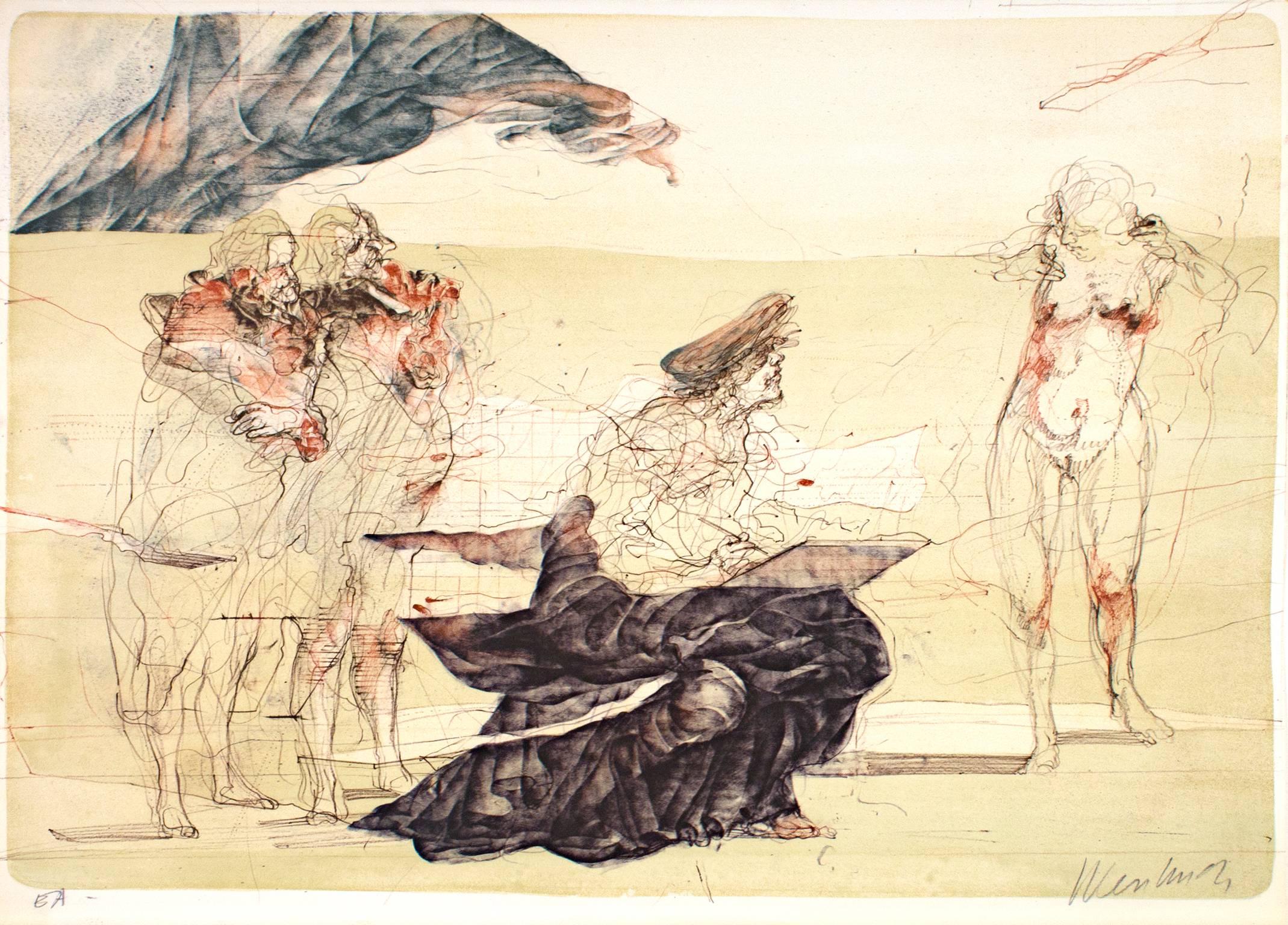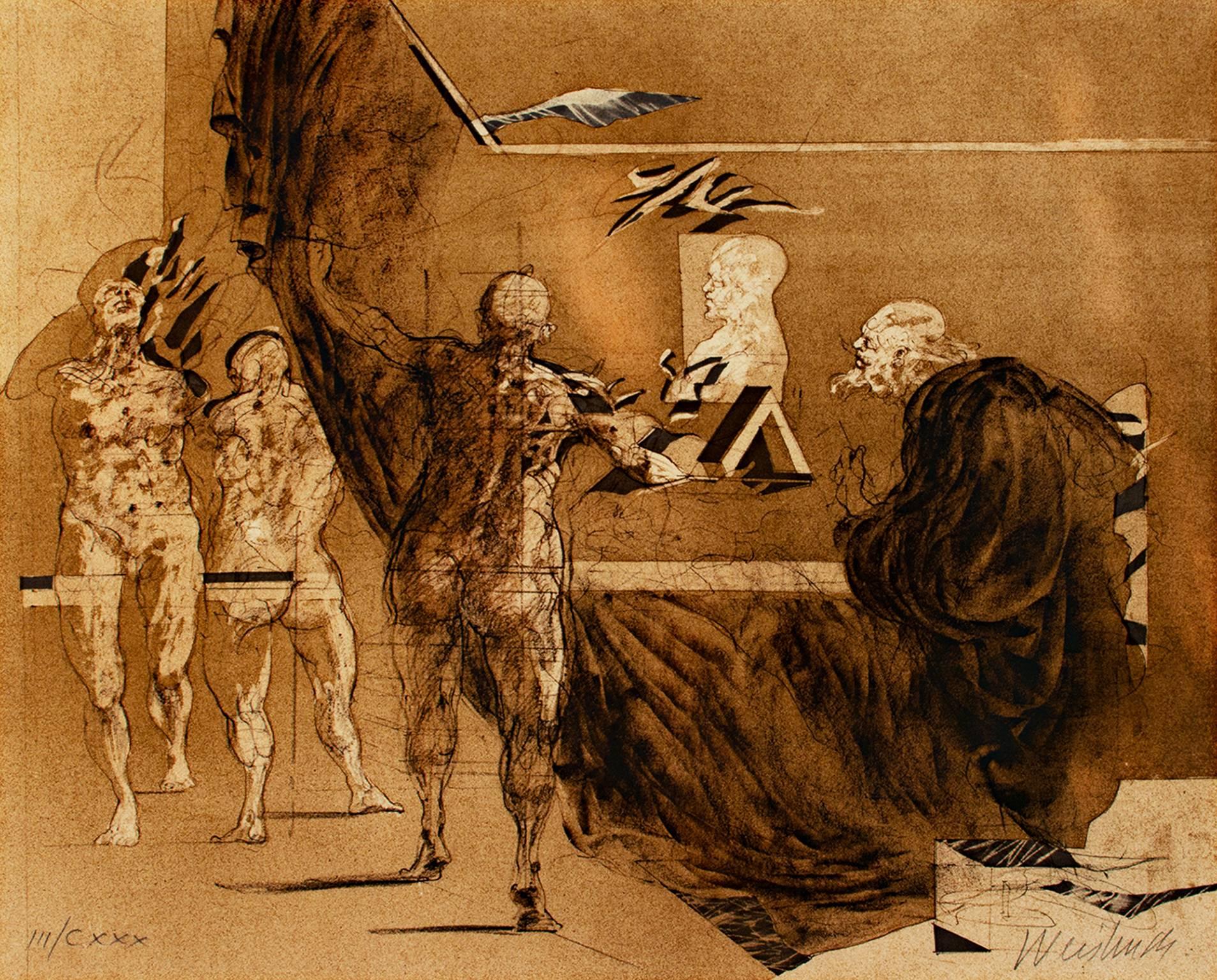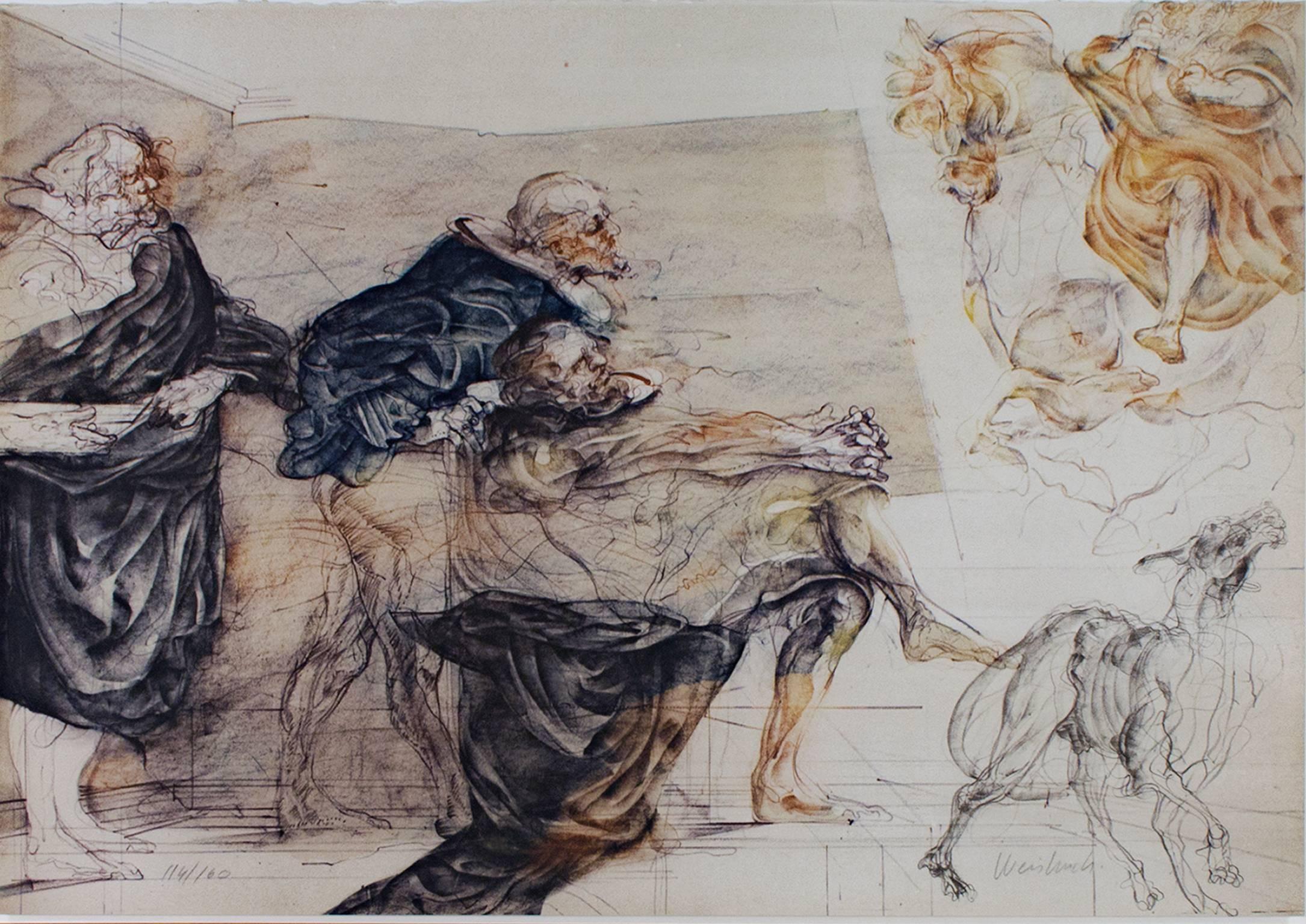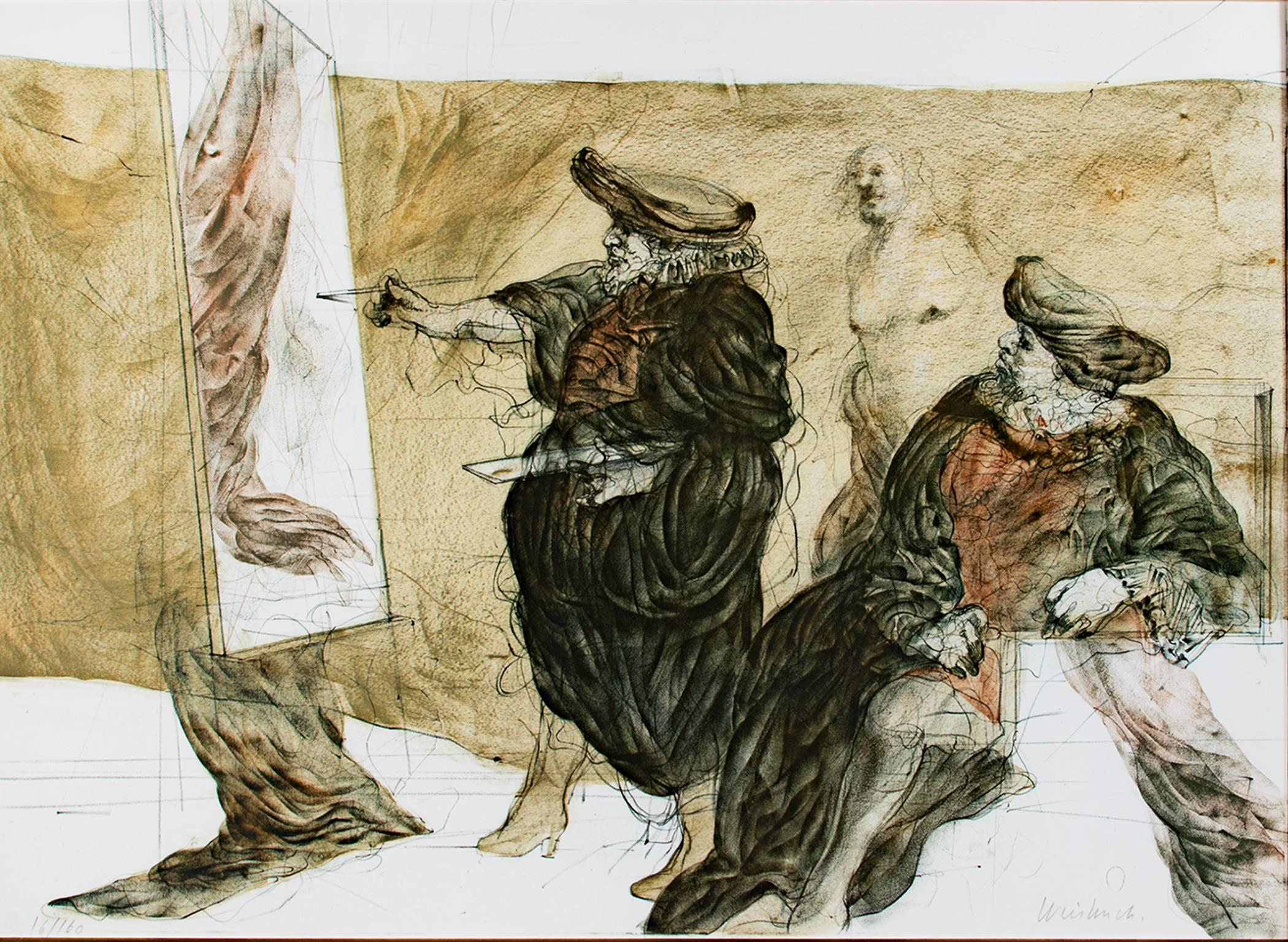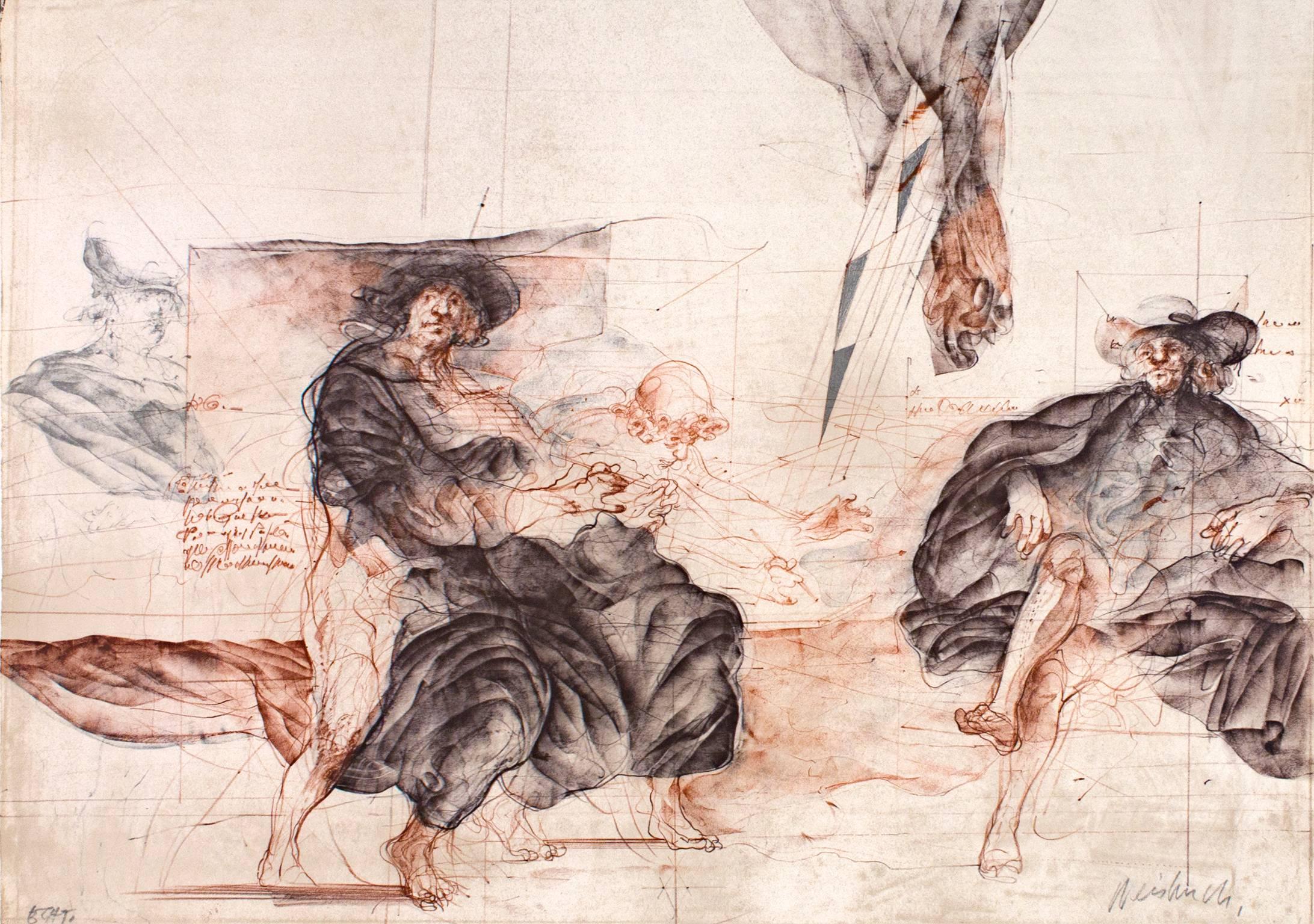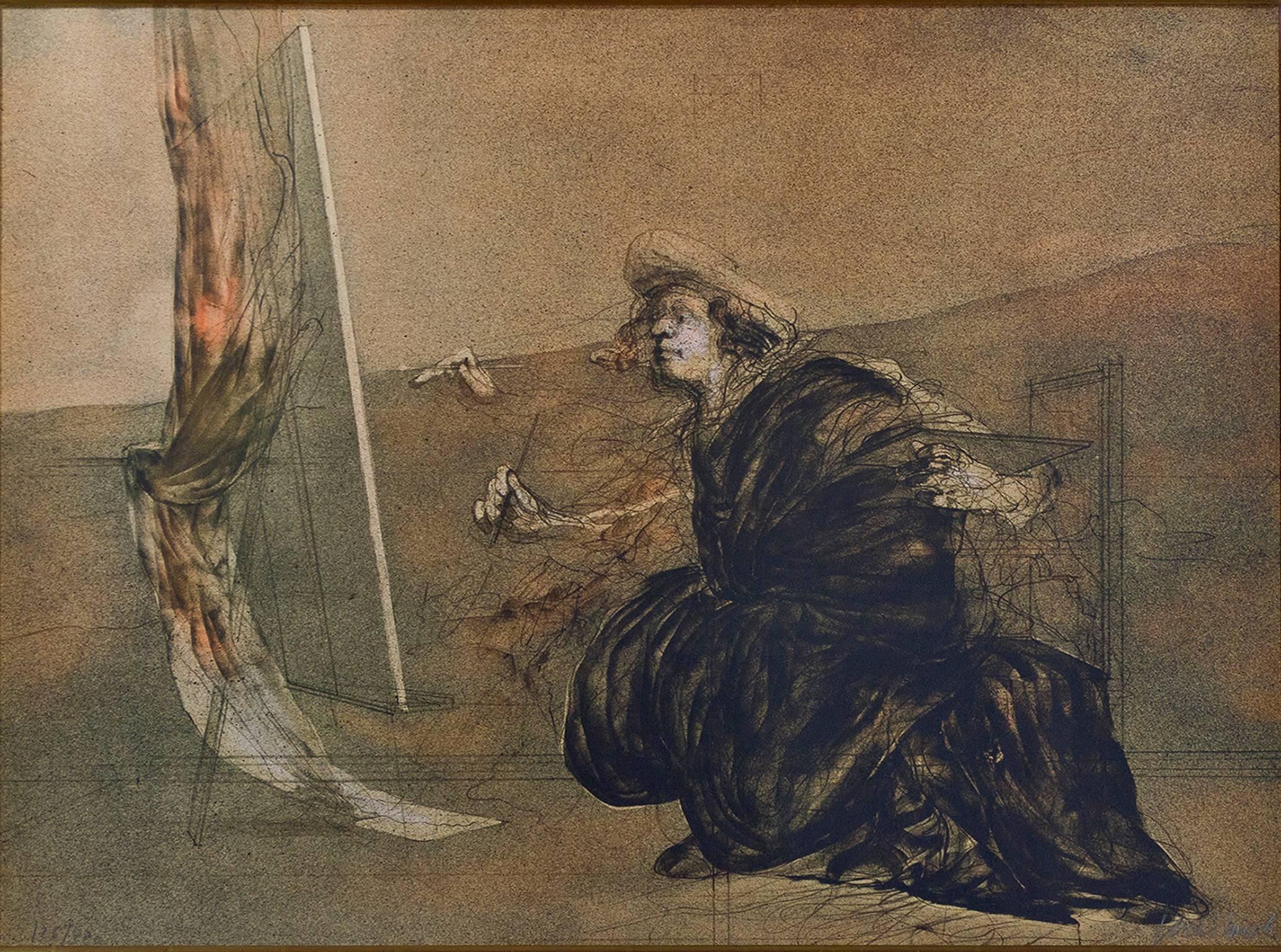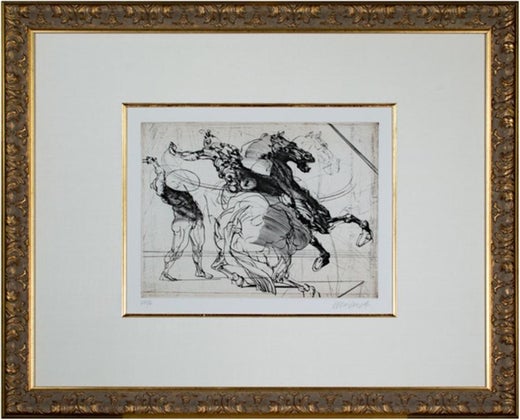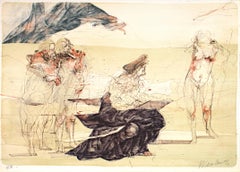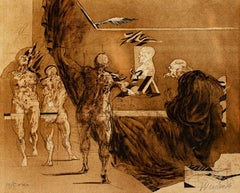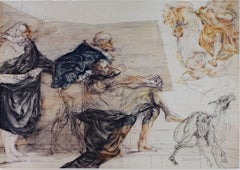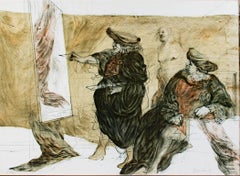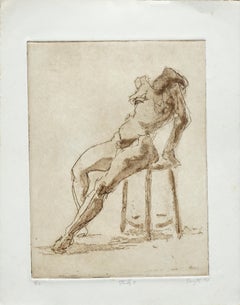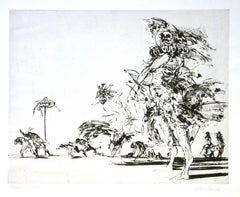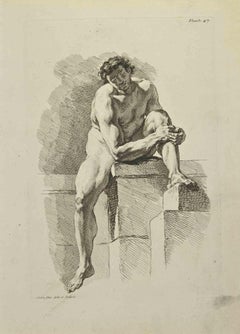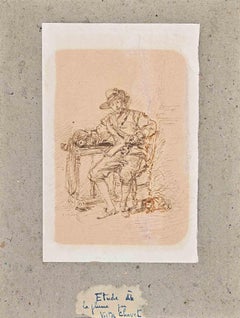Items Similar to "Anatomie d'Un Reve, " Original figurative sketch print signed
Want more images or videos?
Request additional images or videos from the seller
1 of 9
Claude Weisbuch"Anatomie d'Un Reve, " Original figurative sketch print signed1978
1978
$3,000
£2,332.81
€2,652.43
CA$4,322.14
A$4,725.70
CHF 2,470.65
MX$56,849.41
NOK 31,263.59
SEK 29,322.49
DKK 19,805.44
About the Item
"Anatomie d'Un Reve" is an original color lithograph by Claude Weisbuch. The artist signed the piece in the lower right and wrote the edition number, IX/CXXX, in the lower left. This piece depicts an artist in dark robes painting while shadows and faint sketches of figures walk around in the background.
17" x 23 1/4" art
Claude Weisbuch was born on February 8th, 1927 in Thionville, France. His art includes drawing, painting and lithographs. Inventive and unique with his style he uses color range that is warm and rich in tone, certainly equal to that of Rembrandt. The fluidity of line and creation of motion is even more vigorous that in the work of Daumier or Toulouse Lautrec. His creativeness in composition is awesome and seems to have infinite possibilities of variation and vision. Weisbuch died in 2014.
Exhibitions
Herve Odermatt Gallery Paris, France
Escole de Paris Paris, France
David Barnett Gallery Milwaukee,Wisconsin
Education
Ecole des Beaux-Arts de Nancy Nancy, France
- Creator:Claude Weisbuch (1927, French)
- Creation Year:1978
- Dimensions:Height: 17 in (43.18 cm)Width: 23.25 in (59.06 cm)
- Medium:
- Movement & Style:
- Period:
- Condition:
- Gallery Location:Milwaukee, WI
- Reference Number:Seller: 6397g1stDibs: LU605314699432
Claude Weisbuch
Claude Weisbuch was born in Thionville, France in 1927 and was a pupil at L' École des Beaux-Arts de Nancy, France. As a painter, engraver, and exceptional lithographer, Claude Weisbuch has painted active motifs, such as musicians, horses, and characters. Dominating in his work, by the relief and the velvety line which characterizes drypoint, his etchings are the strongest representations of his figures, intensely lively after the 1960s. Using dark tones which express his sharp sense, Claude Weisbuch ceaselessly captures life's dynamics, as the pictorial, musical and literary expressions that are essentially human. Whether it is the impassioned violinist, the mercurial actor, or the sitter shrouded with silent intensity, they have all been rendered with Weisbuch's love for drama. The brushstrokes are sweeping and bold while the paint is fluid. His pictures, full of movement, give one the impression of time-lapsed motion and display an expression of passionate humanity tinged with a unique energy. Weisbuch has been quoted as saying “I like the sketch, the uncompleted, the painting filled with mystery,”. "Some important things to look for in evaluating an artist for such a position of honour are: an inventiveness of style, a prolific output, and a consistency of quality--Claude Weisbuch has all three. His style is unique with a color range that is rich and warm in tone, certainly equal to that of Rembrandt. The fluidity of line and creation of motion is even more vigorous than in the work of Daumier or Toulouse Lautrec. His creativeness in composition is awesome and seems to have infinite possibilities of variation and vision." - David Barnett
About the Seller
4.9
Gold Seller
Premium sellers maintaining a 4.3+ rating and 24-hour response times
Established in 1966
1stDibs seller since 2017
452 sales on 1stDibs
Typical response time: 2 hours
- ShippingRetrieving quote...Shipping from: Milwaukee, WI
- Return Policy
Authenticity Guarantee
In the unlikely event there’s an issue with an item’s authenticity, contact us within 1 year for a full refund. DetailsMoney-Back Guarantee
If your item is not as described, is damaged in transit, or does not arrive, contact us within 7 days for a full refund. Details24-Hour Cancellation
You have a 24-hour grace period in which to reconsider your purchase, with no questions asked.Vetted Professional Sellers
Our world-class sellers must adhere to strict standards for service and quality, maintaining the integrity of our listings.Price-Match Guarantee
If you find that a seller listed the same item for a lower price elsewhere, we’ll match it.Trusted Global Delivery
Our best-in-class carrier network provides specialized shipping options worldwide, including custom delivery.More From This Seller
View All"La Visite des Amateurs, " Original Color figurative sketch print signed
By Claude Weisbuch
Located in Milwaukee, WI
"La Visite des Amateurs" is an original color lithograph by Claude Weisbuch. It is signed in the lower right and editioned "EA" in the lower left. This piece depicts four figures: one artist in black robes, two onlookers, and one female nude model. They appear to be in an endless flat landscape.
22" x 29 7/8" art
Claude Weisbuch was born on February 8th, 1927 in Thionville, France. His art includes drawing, painting and lithographs. Inventive and unique with his style he uses color range that is warm and rich in tone, certainly equal to that of Rembrandt. The fluidity of line and creation of motion is even more vigorous that in the work of Daumier or Toulouse Lautrec. His creativeness in composition is awesome and seems to have infinite possibilities of variation and vision. Weisbuch died in 2014.
Exhibitions
Herve Odermatt Gallery Paris, France
Escole de Paris Paris, France
David Barnett...
Category
1970s Figurative Prints
Materials
Lithograph
20th century color lithograph figurative surrealist print sepia sketch signed
By Claude Weisbuch
Located in Milwaukee, WI
"Le Trait de la Figure" is an original lithograph by Claude Weisbuch. The artist signed the piece lower right and wrote the edition number (III/CXX) in the lower left. This piece dep...
Category
1970s Modern Figurative Prints
Materials
Lithograph
20th century color lithograph figurative print male subjects sketch scene signed
By Claude Weisbuch
Located in Milwaukee, WI
"Le Portrait Equestre" is an original color lithograph by Claude Weisbuch. This piece depicts a number of figures in black robes looking at horses. The a...
Category
1970s Modern Figurative Prints
Materials
Lithograph
20th century color lithograph figurative print male subjects sketch scene signed
By Claude Weisbuch
Located in Milwaukee, WI
"Geste et Peinture" is an original color lithograph by Claude Weisbuch. The artist signed the piece in the lower right and wrote the edition number (16/160) in the lower left. This p...
Category
1970s Modern Figurative Prints
Materials
Lithograph
20th century color lithograph figurative print male subjects sketch scene signed
By Claude Weisbuch
Located in Milwaukee, WI
"La Lecon Du Professor Tulp" is an original lithograph by Claude Weisbuch. The artist signed the piece lower right and wrote the edition (ETAT) in the lower left. This piece depicts ...
Category
1970s Modern Figurative Prints
Materials
Lithograph, Paper
20th century color lithograph figurative print artist easel canvas scene signed
By Claude Weisbuch
Located in Milwaukee, WI
"Artiste Dans l'Atelier" is an original lithograph by Claude Weisbuch. The artist signed the piece lower right and wrote the edition number (126/320) in the lower left. This piece de...
Category
1970s Modern Figurative Prints
Materials
Lithograph
You May Also Like
"Study 2" Figurative Lithograph
By Jim Smyth
Located in Soquel, CA
Nude figurative lithograph by Jim Smyth (American, b. 1938). Numbered, titled, signed and dated "5/12", "Study 2", "Smyth 74” along the bottom edge. Unframed.
Jim Smyth has studied at the Academia de Belle Arti in Fiorenza, Italy, Ecole des BeauxArts in Geneva, New York Academy, and the Art Students League. He is also a graduate of UC Berkeley with a degree in Fine Art.
Although academically trained, Smyth practices and teaches a more impressionistic style of painting, focusing on the Alla Prima technique.
He is particularly knowledgeable about drawing, perspective, color theory and the human figure, his passion. Smyth, with extensive academic knowledge, has a profound love of all human representations as illustrated by his humorous quick sketches from life. He also practices and teaches oil painting and pastels.
When not in Provence, or Southeastern France, Smyth teaches intensely in art schools, art centers and several colleges in the Bay Area. He is a beloved instructor and his classes fill in quickly as he is very knowledgeable.
On his return to the United States, he began studying with Mr. Alanson Appleton at the College of San Mateo, San Mateo, California. Smyth was a founding member of the Appletree Etchers, Inc., an etching print shop organized by Mr. Appleton and his students to develop and promote color intaglio. Smyth served as Master Printer at the studio for many years perfecting the techniques of intaglio and developing the color theories of Mr. Appleton as applied to the deeply etched plate.
Smyth received his degree from the University of California, Berkeley, in 1972 and holds the California Community College Certificate and an Adult Education Certificate. Smyth was invited to teach "Anatomy for Artists" at Foothill College, Los Altos Hills, California, as a result of his many years of dissection of the cadaver and developed the course of study of Perspective for the college. During this period, he began teaching Life Drawing at the Pacific Art League of Palo Alto, Palo Alto, California. During the following thirty years Smyth has taught an average of twelve classes per week at the Pacific Art League of Palo Alto, the Palo Alto Art Center and the Burlingame Recreation Department among others in all phases of drawing and painting. He has conducted many workshops for the California Academy of Painters in many aspects of drawing and painting. Currently, he is an Adjunct Professor of Drawing at the College of San Mateo, San Mateo, California. He is an authority on the materials of painting and drawing, techniques of traditional drawing and painting, color theory, perspective and anatomy for artists. In his career in Life Drawing, Smyth has made over two hundred thousand drawings from the model.
In addition to studies at Berkeley, Smyth has studied at the College of San Mateo, Foothill College, De Anza College, Mission College, and West Valley College, all in California. One of the pivotal points in his career was studying with Mr. Maynard Dixon Stewart at the University of San Jose, California. He spent a year at the New York Academy of Art where he was offered a full scholarship and at the Art Students League of New York. He concurrently attended classes at the National Academy of Design in New York. Among others, Smyth studied with M. Andrejivec, Ted Schmidt, Elliot Goldfinger, Gary Fagin, Ted Jacobs, Leo Neufeld, David Leffel, Jack Ferragasso, Jim Childs and Everett Raymond Kinstler and Kim English. Smyth has also studied with the noted painter and colorist, Ovanes Berberian...
Category
1970s American Impressionist Figurative Prints
Materials
Paper, Etching
$520 Sale Price
20% Off
Claude Weisbuch - The Angel of Death - Signed and Numbered Engraving
By Claude Weisbuch
Located in Collonge Bellerive, Geneve, CH
Claude WEISBUCH
The angel of death
Original drypoint engraving on Vellum paper
Handsigned on bottom right
56 x 76 cm
Claude Weisbuch, French (1927 - 2...
Category
1970s Modern Abstract Prints
Materials
Drypoint
Anatomy Studies - Etching by Nicholas Cochin - 1755
Located in Roma, IT
Anatomy Studies is an etching realized by Nicholas Cochin in 1755.
Good conditions with foxing and folding.
Signed in the plate.
The artwork is depicted through confident strokes....
Category
1750s Surrealist Figurative Prints
Materials
Etching
$183 Sale Price
40% Off
Study of Study of Figure - Drawing by Victor Chavet - Mid-19th Century
Located in Roma, IT
Study of Figure is a China ink Drawing realized in the mid-19th Century by Victor Chavet (1822-1906).
Hand-signed on the lower.
Glued on a hard Cardboard Passepartout: 28 x 21 cm, original one by the publisher, on the rear Stamped " Adolphe Legoupy, Paris"
Good condition with a repaired central part.
Victor Chavet (1822-1906) was a pupil of Pierre Révoil in Lyon then of Camille Roqueplan...
Category
Mid-19th Century Modern Figurative Drawings and Watercolors
Materials
Paper, Ink
The Anatomical Sketches - Pencil Drawing - Mid 20th Century
By Gustave Bourgogne
Located in Roma, IT
The Anatomical Sketches is an original Drawing in pencil on ivory-colored paper attributed to Gustave Bourgogne in the early 20th century.
Good conditions.
The artwork is represent...
Category
Mid-20th Century Modern Figurative Drawings and Watercolors
Materials
Pencil
Nude and portrait sketches - Original signed drawing
By Edouard Goerg
Located in Paris, IDF
Edouard Goerg (1893 - 1969)
Nude and portrait sketches
Original black ink drawing
Signed with the stamp of the artist
Paper size 10 x 13 inches
Another drawing on the backside
Excel...
Category
1950s Modern Nude Drawings and Watercolors
Materials
India Ink
More Ways To Browse
Henry Moore Lithograph Signed
Hirst Minnie
Hokusai Original Print
Ian Hugo
Jacques Marie Gaston Onfroy De Breville
James Boynton
John Lennon Lithograph
Kaws Lithograph
Kaws Urge
Keith Haring Safe Sex
Le Carmen Des Carmen
Leo Jacobs
Leroy Neiman Signed Serigraphs
Les Cavaliers Dali
Les Vitraux
Love Me Kulig
Magritte Poster
Marc Chagall 1974
